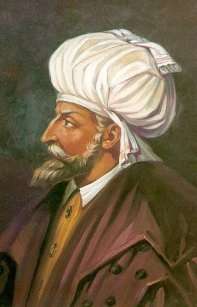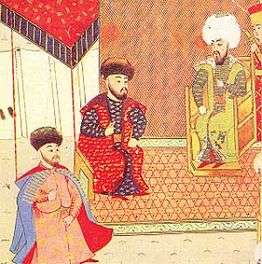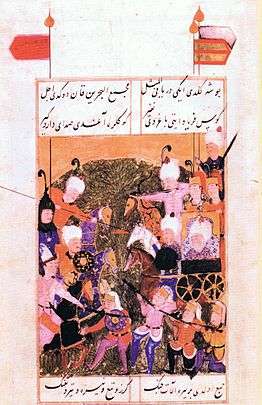Bayezid II
| Bayezid II بايزيد ثانى | |||||
|---|---|---|---|---|---|
|
Sultan of the Ottoman Empire Padişah | |||||
 | |||||
| 8th Ottoman Sultan (Emperor) | |||||
| Reign | 22 May 1481 – 24 April 1512 | ||||
| Predecessor | Mehmed the Conqueror | ||||
| Successor | Selim I | ||||
| Born | 3 December 1447 | ||||
| Died |
26 May 1512 (aged 64) Büyükçekmece | ||||
| Consort |
Sultan Hatun Nigar Hatun Şirin Hatun Gülruh Hatun Bülbül Hatun Hüsnüşah Hatun Gülbahar Hatun Muhtereme Hatun | ||||
| |||||
| Dynasty | Osmanli (Ottoman) | ||||
| Father | Mehmed II | ||||
| Mother |
Emine Gülbahar Hatun[1] or Sittişah Hatun[2][3] | ||||
| Religion | Sunni Islam | ||||
| Tughra |
| ||||
Bayezid II or Sultân Bayezid-î Velî (3 December 1447 – 26 May 1512) (Ottoman Turkish: بايزيد ثانى Bāyezīd-i sānī, Turkish:II. Bayezid or II. Beyazıt) was the eldest son and successor of Mehmed II, ruling as Sultan of the Ottoman Empire from 1481 to 1512. During his reign, Bayezid II consolidated the Ottoman Empire and thwarted a Safavid rebellion soon before abdicating his throne to his son, Selim I. He is most notable for evacuating Jews from Spain after the proclamation of the Alhambra Decree and resettling them throughout the Ottoman Empire.
Early life
Bayezid II was the son of Mehmed II (1432–81) and Emine Gülbahar Hatun.
Bayezid II married Gülbahar Hatun, who was the mother of his eldest son Şehzade Ahmet, as well as Bayezid II's heir and successor, Selim I and nephew of Sitti Mükrime Hatun.
Fight for the throne
Bayezid II's overriding concern was the quarrel with his brother Cem, who claimed the throne and sought military backing from the Mamluks in Egypt. Having been defeated by his brother's armies, Cem sought protection from the Knights of St. John in Rhodes. Eventually, the Knights handed Cem over to Pope Innocent VIII (1484–1492). The Pope thought of using Cem as a tool to drive the Turks out of Europe, but as the papal crusade failed to come to fruition, Cem was left to languish and die in a Neapolitan prison. Bayezid II paid both the Knights Hospitaller and the pope to keep his brother prisoner.
Reign
Bayezid II ascended the Ottoman throne in 1481.[4] Like his father, Bayezid II was a patron of western and eastern culture. Unlike many other Sultans, he worked hard to ensure a smooth running of domestic politics, which earned him the epithet of "the Just". Throughout his reign, Bayezid II engaged in numerous campaigns to conquer the Venetian possessions in Morea, accurately defining this region as the key to future Ottoman naval power in the Eastern Mediterranean. The last of these wars ended in 1501 with Bayezid II in control of the whole Peloponnese. Rebellions in the east, such as that of the Qizilbash, plagued much of Bayezid II's reign and were often backed by the Shah of Persia, Ismail, who was eager to promote Shi'ism to undermine the authority of the Ottoman state. Ottoman authority in Anatolia was indeed seriously threatened during this period and at one point Bayezid II's grand vizier, Ali Pasha, was killed in battle against rebels.
Jewish and Muslim immigration
In July 1492, the new state of Spain expelled its Jewish and Muslim populations as part of the Spanish Inquisition. Bayezid II sent out the Ottoman Navy under the command of Admiral Kemal Reis to Spain in 1492 in order to evacuate them safely to Ottoman lands. He sent out proclamations throughout the empire that the refugees were to be welcomed.[5] He granted the refugees the permission to settle in the Ottoman Empire and become Ottoman citizens. He ridiculed the conduct of Ferdinand II of Aragon and Isabella I of Castile in expelling a class of people so useful to their subjects. "You venture to call Ferdinand a wise ruler," he said to his courtiers, "he who has impoverished his own country and enriched mine!"[6] Bayezid addressed a firman to all the governors of his European provinces, ordering them not only to refrain from repelling the Spanish refugees, but to give them a friendly and welcome reception.[6] He threatened with death all those who treated the Jews harshly or refused them admission into the empire. Moses Capsali, who probably helped to arouse the sultan's friendship for the Jews, was most energetic in his assistance to the exiles. He made a tour of the communities and was instrumental in imposing a tax upon the rich, to ransom the Jewish victims of the persecution.

The Muslims and Jews of al-Andalus (Iberia) contributed much to the rising power of the Ottoman Empire by introducing new ideas, methods and craftsmanship. The first printing press in Constantinople was established by the Sephardic Jews in 1493. It is reported that under Bayezid's reign, Jews enjoyed a period of cultural flourishing, with the presence of such scholars as the Talmudist and scientist Mordecai Comtino; astronomer and poet Solomon ben Elijah Sharbiṭ ha-Zahab; Shabbethai ben Malkiel Cohen, and the liturgical poet Menahem Tamar.
Succession
On September 14, 1509, Constantinople[7][8] was devastated by an earthquake. During Bayezid II's final years, a succession battle developed between his sons Selim I and Ahmet. Ahmet unexpectedly captured Karaman, an Ottoman city, and began marching to Constantinople to exploit his triumph. Fearing for his safety, Selim staged a revolt in Thrace but was defeated by Bayezid and forced to flee back to the Crimean Peninsula. Bayezid II developed fears that Ahmet might in turn kill him to gain the throne, so he refused to allow his son to enter Constantinople.
Selim returned from Crimea and, with support from the Janissaries, forced his father to abdicate the throne on April 25, 1512. Bayezid departed for retirement in his native Demotika, but he died on May 26, 1512 at Büyükçekmece before reaching his destination and only a month after his abdication. He was buried next to the Bayezid Mosque in Istanbul.

In popular culture
- Sultan Bayezid II's statesmanship, tolerance, and intellectual abilities are depicted in the historical novel The Sultan's Helmsman, which takes place in the middle years of his reign.
- Sultan Bayezid II and his struggle with his son Selim is a prominent subplot in the video game Assassin's Creed: Revelations. In the game, due to Bayezid's absence from Constantinople, the Byzantines had the opportunity to sneak back into the city, hoping to revive their fallen empire. Near the end of the game, Bayezid surrendered the throne to his son Selim. However, Bayezid does not make an actual appearance.
- Bayezid II, prior to becoming Sultan, is depicted by Akin Gazi in the Starz series, Da Vinci's Demons. He seeks an audience with Pope Sixtus IV (having been manipulated into believing that peace between Rome and Constantinople is a possibility), only to be ridiculed and humiliated by Sixtus, actions which later serve as a pretext for the Ottoman invasion of Otranto. Sixtus assumes that Bayezid has been overlooked in favor of his brother Cem.
Family
- Consorts
- Sultan Hatun, daughter of Emir Bey of Amasya;
- Nigar Hatun, daughter of Abdullah Vehbi Bey;
- Şirin Hatun;
- Bülbül Hatun;
- Gülbahar Hatun, daughter of Alaeddevle Borkurt Bey of Dulkadir Beylik;
- Gülruh Hatun;
- Hüsnüşah Hatun, daughter of Cambaz Kadioğlu Nasuh Bey of the Karamanids;
- Muhtereme Hatun;
- Sons
- Şehzade Sultan Abdullah - son with Şirin Hatun,[9] Governor of Sarihan 1481, and of Karaman 1481-1483
- Şehzade Sultan Ahmed - son with Bülbül Hatun,[10] Governor of Sarihan 1481-1483 and of Amasya 1483-1513
- Şehzade Sultan Korkud - son with Nigar Hatun,[9] Governor of Sarihan 1483-1501 and 1511-1513, and of Anatolia 1502-1509 and 1510-1511
- Sultan Selim I - son with Gülbahar Hatun,[11] who succeeded as Sultan Selim Khan I Yavuz
- Şehzade Sultan Şehinşah - son with Hüsnüşah Hatun,[9] Governor of Sarihan 1481-1483 and of Karaman 1483-1511
- Şehzade Sultan Alemşah - son with Gülruh Hatun,[11] Governor of Kastamonu 1504 and of Sarihan 1504-1507
- Şehzade Sultan Mehmed - son with Muhtereme Hatun, Governor of Kefe
- Şehzade Sultan Mahmud - son with Bülbül Hatun,[10] Governor of Sarihan 1502
- Daughters
- Aynışah Hatun, daughter with Şirin Hatun, married in 1490 to Prince Damat Sultan Ahmed Göde Akkoyunlu;[12]
- Ayşe Hatun - daughter with Nigar Hatun, married Güveyi Sinan Paşa;[12]
- Sofiye Sultan Fatma Hatun - daughter with Nigar Hatun, married to Damad Güzelce Hasan Bey;[13]
- Gevhermülük Şah Hatun - daughter with Bülbül Hatun, married to Damat Mehmed Pasha Dukakis;[13]
- Hatice Hatun - daughter with Bülbül Hatun, married to Damat Faik Pasha;[14]
- Hundi Hatun - daughter with Bülbül Hatun, married in 1484 to Damat Hersekzade Ahmed Pasha;[14]
- Hümaşah Hatun, married to Damat Antalyali Bali Pasha;[15]
- Ilaldi Hatun, married to Damat Hain Ahmed Pasha;[15]
- Kamerşah Hatun - daughter with Gülruh Hatun, married in 1490 to Damat Mustafa Bey, son of Davud Pasha;[15]
- Selçukşah Hatun, married in 1485 to Damat Mehmed Bey, son of Damat Kara Mustafa Pasha;[15]
- Şehzade Şah Hatun - daughter with Bülbül Hatun, married in 1490 to Damat Nasuh Bey;[16]
- Sultanzade Hatun - daughter with Hüsnüşah Hatun;[16]
References
- Notes
- ↑ Necdet Sakaoğlu (2008). Bu mülkün kadın sultanları: Vâlide sultanlar, hâtunlar, hasekiler, kadınefendiler, sultanefendiler. Oğlak publications. pp. 110–112. ISBN 978-9-753-29623-6. (The name of the real biological mother of Bayezid II is given as Meliketû'l-Melikât Gül-Bahar Valide Hâtun).
- ↑ Bahadıroğlu, Yavuz (2009) Ottoman History with Illustrations - Resimli Osmanlı Tarihi, Nesil Publications, 15th Ed., p. 129, ISBN 978-975-269-299-2. (www.nesilyayinlari.com)
- ↑ Necdet Sakaoğlu (2008). Bu mülkün kadın sultanları: Vâlide sultanlar, hâtunlar, hasekiler, kadınefendiler, sultanefendiler. Oğlak publications. pp. 113–117. ISBN 978-9-753-29623-6..
- ↑ "Sultan Bajazid's (i.e., Beyazit's) Mosque, Constantinople, Turkey". World Digital Library. 1890–1900. Retrieved 2013-10-18.
- ↑ Egger, Vernon O. (2008). A History of the Muslim World Since 1260: The Making of a Global Community. Prentice Hall. p. 82. ISBN 0-13-226969-4.
- 1 2 The Jewish Encyclopedia: a descriptive record of the history, religion, literature, and customs of the Jewish people from the earliest times to the present day, Vol.2 Isidore Singer, Cyrus Adler, Funk and Wagnalls, 1912 p.460
- ↑ The Encyclopædia Britannica, Vol.7, Edited by Hugh Chisholm, (1911), 3; Constantinople, the capital of the Turkish Empire...
- ↑ Britannica, Istanbul:When the Republic of Turkey was founded in 1923, the capital was moved to Ankara, and Constantinople was officially renamed Istanbul in 1930.
- 1 2 3 Uluçay 1988, p. 46.
- 1 2 Uluçay 1988, p. 44.
- 1 2 Uluçay 1988, p. 45.
- 1 2 Uluçay 1988, p. 48.
- 1 2 Uluçay 1988, p. 49.
- 1 2 Uluçay 1988, p. 50.
- 1 2 3 4 Uluçay 1988, p. 51.
- 1 2 Uluçay 1988, p. 52.
- Bibliography
- Sidney Nettleton Fisher. "The foreign relations of Turkey (1481–1512)" (PDF). Utrecht University.
-
 This article incorporates text from a publication now in the public domain: Singer, Isidore; et al., eds. (1901–1906). "Bajazet II". Jewish Encyclopedia. New York: Funk & Wagnalls Company.
This article incorporates text from a publication now in the public domain: Singer, Isidore; et al., eds. (1901–1906). "Bajazet II". Jewish Encyclopedia. New York: Funk & Wagnalls Company. - M. Çağatay Uluçay (1985). Padişahların kadınları ve kızları. Türk Tarih Kurumu.
External links
-
 Media related to Bayezid II at Wikimedia Commons
Media related to Bayezid II at Wikimedia Commons
| Bayezid II Born: Dec 3, 1447 Died: May 26, 1512 | ||
| Regnal titles | ||
|---|---|---|
| Preceded by Mehmed II |
Sultan of the Ottoman Empire May 3, 1481 – April 25, 1512 |
Succeeded by Selim I |
| Titles in pretence | ||
| Preceded by Mehmed II |
Byzantine Emperor | Claim merged into Sultanate |
| Caliph of Islam | Succeeded by Selim I | |